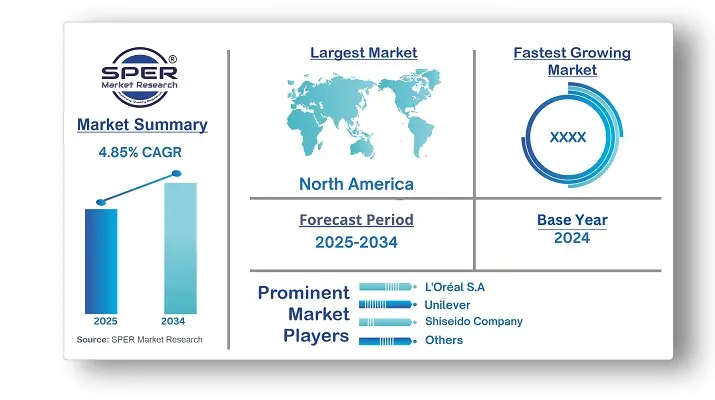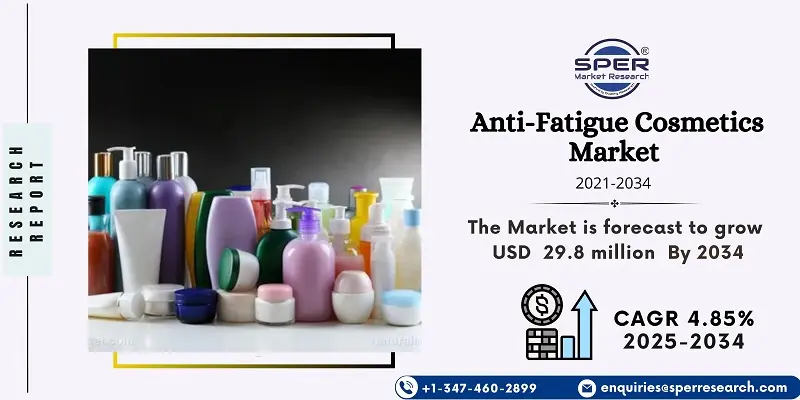Anti-Fatigue Cosmetics Market Introduction and Overview
According to SPER Market Research, the Global Anti-Fatigue Cosmetics Market is estimated to reach USD 29.8 million by 2034 with a CAGR of 4.85%.
The report includes an in-depth analysis of the Global Anti-Fatigue Cosmetics Market, including market size and trends, product mix, Applications, and supplier analysis. The market for anti-fatigue cosmetics is growing as customers look for skincare and cosmetic products to counteract weariness, stress, and environmental harm. Energizing elements like caffeine, antioxidants, and peptides are used in the formulation of these products, which include eye creams, serums, and masks, to revive the skin. Increasing urbanization, expanding consumer awareness of self-care, and the growing need for multipurpose beauty products are some of the main causes. Additionally driving the industry are advancements in skincare technologies and social media's impact. Growth might be impeded by obstacles like high product costs, competition from natural alternatives, and consumer skepticism over efficacy. Nevertheless, further developments in formulation and marketing are anticipated to propel market growth.

By Product Insights
Anti-Fatigue Cosmetics is classified into five categories based on Product: Cream, Oil, Lotion, Serum and Gel. The market was controlled by cream. This market is growing as a result of increased awareness of the use of body care and cosmetics. The serum market is anticipated to expand considerably over the course of the projected period. In order to preserve youthful skin, Gen Xers and millennial are becoming more and more interested in using anti-fatigue solutions. This is one of the main factors propelling the market expansion for the serum sector.
By Distribution Channel Insights
The market for Anti-Fatigue Cosmetics is segmented based on Distribution Channel, including Offline, Online. The market was controlled by the offline distribution sector. Brands have concentrated a lot on influencing offline distribution through pharmacies, supermarkets, and hypermarkets, particularly in the consumer products sector. Over the course of the forecast period, the online segment is anticipated to develop at the quickest CAGR. The online portion of this market is expanding as a result of the e-commerce industry's expansion, which makes it simple for customers to purchase goods whenever it's convenient for them.
By End User Insights
The market for Anti-Fatigue Cosmetics is divided into many end users, including Women, Men. The market was dominated by the female user segment. Generally speaking, women use cosmetics at higher rates than males. Growth in this market is driven by growing awareness of skin health, appearance, and personal hygiene. Over the course of the forecast period, the men's users’ category is anticipated to increase at the quickest CAGR. The market for men's grooming products has been pushed by growing awareness of the negative consequences of pollution, inconsistent sleep patterns, and unhealthy lifestyles.
By Regional Insights
The global market for anti-fatigue cosmetics was led by North America. The demand for anti-fatigue goods has increased in the area due to the availability of several well-known brands, accessibility through offline and online channels, and alluring discounts and offers from businesses and merchants. Additionally, the expansion of this regional industry has been fuelled by increased awareness of personal care and the importance of skin health.
Market Competitive Landscape
The leading companies in the sector have implemented tactics like improved branding, partnerships, influencer partnerships, distribution network expansion, increased online market presence, and research and development to achieve new product launches as a result of the heightened competition. Some of the key market players are L'Oréal S.A., Unilever, Shiseido Company, Limited, The Estée Lauder Companies Inc., Bio Veda Action Research Co. (Biotique), Christian Dior SE, Nuxe, Groupe Clarins, DECIEM Beauty Group Inc., Zymo.
Recent Developments:
In March 2024, the novel aspect Melasyl was released by L'ORÉAL Paris. According to the company, as Melasyl can target specific skin pigmentation, which might result in post-acne blemishes and aging spots.
In February 2024, According to Shiseido, an established company in the cosmetics sector, it has created a new technology for a skin lotion formulation that should result in better skin care outcomes. The effective and consistent introduction of active substances into the skin is made feasible by this technology
Scope of the report:
| Report Metric | Details |
| Market size available for years | 2021-2034 |
| Base year considered | 2024 |
| Forecast period | 2025-2034 |
| Segments covered | By Product, By Distribution Channel, By End User |
| Regions covered | North America, Latin America, Asia-Pacific, Europe, and Middle East & Africa |
| Companies Covered | L'Oréal S.A., Unilever, Shiseido Company, Limited, The Estée Lauder Companies Inc., Bio Veda Action Research Co. (Biotique), Christian Dior SE, Nuxe, Groupe Clarins, DECIEM Beauty Group Inc., Zymo. |
Key Topics Covered in the Report
- Global Anti-Fatigue Cosmetics Market Size (FY’2021-FY’2034)
- Overview of Global Anti-Fatigue Cosmetics Market
- Segmentation of Global Anti-Fatigue Cosmetics Market By Product (Cream, Oil, Lotion, Serum, Gel)
- Segmentation of Global Anti-Fatigue Cosmetics Market By Distribution Channel (Offline, Online)
- Segmentation of Global Anti-Fatigue Cosmetics Market By End User (Women, Men)
- Statistical Snap of Global Anti-Fatigue Cosmetics Market
- Expansion Analysis of Global Anti-Fatigue Cosmetics Market
- Problems and Obstacles in Global Anti-Fatigue Cosmetics Market
- Competitive Landscape in the Global Anti-Fatigue Cosmetics Market
- Details on Current Investment in Global Anti-Fatigue Cosmetics Market
- Competitive Analysis of Global Anti-Fatigue Cosmetics Market
- Prominent Players in the Global Anti-Fatigue Cosmetics Market
- SWOT Analysis of Global Anti-Fatigue Cosmetics Market
- Global Anti-Fatigue Cosmetics Market Future Outlook and Projections (FY’2025-FY’2034)
- Recommendations from Analyst
1. Introduction
1.1. Scope of the report
1.2. Market segment analysis
2. Research Methodology
2.1. Research data source
2.1.1. Secondary Data
2.1.2. Primary Data
2.1.3. SPER’s internal database
2.1.4. Premium insight from KOL’s
2.2. Market size estimation
2.2.1. Top-down and Bottom-up approach
2.3. Data triangulation
3. Executive Summary
4. Market Dynamics
4.1. Driver, Restraint, Opportunity and Challenges analysis
4.1.1. Drivers
4.1.2. Restraints
4.1.3. Opportunities
4.1.4. Challenges
5. Market variable and outlook
5.1. SWOT Analysis
5.1.1. Strengths
5.1.2. Weaknesses
5.1.3. Opportunities
5.1.4. Threats
5.2. PESTEL Analysis
5.2.1. Political Landscape
5.2.2. Economic Landscape
5.2.3. Social Landscape
5.2.4. Technological Landscape
5.2.5. Environmental Landscape
5.2.6. Legal Landscape
5.3. PORTER’s Five Forces
5.3.1. Bargaining power of suppliers
5.3.2. Bargaining power of buyers
5.3.3. Threat of Substitute
5.3.4. Threat of new entrant
5.3.5. Competitive rivalry
5.4. Heat Map Analysis
6. Competitive Landscape
6.1. Global Anti-Fatigue Cosmetics Market Manufacturing Base Distribution, Sales Area, Product Type
6.2. Mergers & Acquisitions, Partnerships, Product Launch, and Collaboration in Global Anti-Fatigue Cosmetics Market
7. Global Anti-Fatigue Cosmetics Market, By Product 2021-2034 (USD Million)
7.1. Cream
7.2. Oil
7.3. Lotion
7.4. Serum
7.5. Gel
8. Global Anti-Fatigue Cosmetics Market, By Distribution Channel 2021-2034 (USD Million)
8.1. Offline
8.2. Online
9. Global Anti-Fatigue Cosmetics Market, By End User 2021-2034 (USD Million)
9.1. Women
9.2. Men
10. Global Anti-Fatigue Cosmetics Market, 2021-2034 (USD Million)
10.1. Global Anti-Fatigue Cosmetics Market Size and Market Share
11. Global Anti-Fatigue Cosmetics Market, By Region, 2021-2034 (USD Million)
11.1. Asia-Pacific
11.1.1. Australia
11.1.2. China
11.1.3. India
11.1.4. Japan
11.1.5. South Korea
11.1.6. Rest of Asia-Pacific
11.2. Europe
11.2.1. France
11.2.2. Germany
11.2.3. Italy
11.2.4. Spain
11.2.5. United Kingdom
11.2.6. Rest of Europe
11.3. Middle East and Africa
11.3.1. Kingdom of Saudi Arabia
11.3.2. United Arab Emirates
11.3.3. Qatar
11.3.4. South Africa
11.3.5. Egypt
11.3.6. Morocco
11.3.7. Nigeria
11.3.8. Rest of Middle-East and Africa
11.4. North America
11.4.1. Canada
11.4.2. Mexico
11.4.3. United States
11.5. Latin America
11.5.1. Argentina
11.5.2. Brazil
11.5.3. Rest of Latin America
12. Company Profile
12.1. Bio Veda Action Research Co. (Biotique)
12.1.1. Company details
12.1.2. Financial outlook
12.1.3. Product summary
12.1.4. Recent developments
12.2. Christian Dior SE
12.2.1. Company details
12.2.2. Financial outlook
12.2.3. Product summary
12.2.4. Recent developments
12.3. DECIEM Beauty Group Inc.
12.3.1. Company details
12.3.2. Financial outlook
12.3.3. Product summary
12.3.4. Recent developments
12.4. Groupe Clarins
12.4.1. Company details
12.4.2. Financial outlook
12.4.3. Product summary
12.4.4. Recent developments
12.5. L’Oréal S.A.
12.5.1. Company details
12.5.2. Financial outlook
12.5.3. Product summary
12.5.4. Recent developments
12.6. Nuxe
12.6.1. Company details
12.6.2. Financial outlook
12.6.3. Product summary
12.6.4. Recent developments
12.7. Shiseido Company, Limited
12.7.1. Company details
12.7.2. Financial outlook
12.7.3. Product summary
12.7.4. Recent developments
12.8. The Estee Lauder Companies Inc
12.8.1. Company details
12.8.2. Financial outlook
12.8.3. Product summary
12.8.4. Recent developments
12.9. Unilever
12.9.1. Company details
12.9.2. Financial outlook
12.9.3. Product summary
12.9.4. Recent developments
12.10. Zymo
12.10.1. Company details
12.10.2. Financial outlook
12.10.3. Product summary
12.10.4. Recent developments
12.11. Others
13. Conclusion
14. List of Abbreviations
15. Reference Links
SPER Market Research’s methodology uses great emphasis on primary research to ensure that the market intelligence insights are up to date, reliable and accurate. Primary interviews are done with players involved in each phase of a supply chain to analyze the market forecasting. The secondary research method is used to help you fully understand how the future markets and the spending patterns look likes.
The report is based on in-depth qualitative and quantitative analysis of the Product Market. The quantitative analysis involves the application of various projection and sampling techniques. The qualitative analysis involves primary interviews, surveys, and vendor briefings. The data gathered as a result of these processes are validated through experts opinion. Our research methodology entails an ideal mixture of primary and secondary initiatives.





































